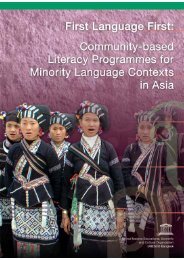Part II.pdf - MTB-MLE Network
Part II.pdf - MTB-MLE Network
Part II.pdf - MTB-MLE Network
Create successful ePaper yourself
Turn your PDF publications into a flip-book with our unique Google optimized e-Paper software.
need more trees to build houses and more cultivated land to match their needs for shelter and food.<br />
This will inevitably lead to destruction of the natural environment.<br />
From the field survey, we see that the functional adult illiteracy rate is high. The villagers have<br />
access to very few social services and live in poverty. Illiteracy is viciously connected with poverty<br />
in the community. The disadvantaged Nanuoke and Banli communities have long been isolated<br />
from the outer world, and there is little communication with other people. Local people are slow<br />
to adopt new approaches, prefer to maintain their present situations and are hesitant to adopt new<br />
technology into their farming. Local people believe that their world is the Nanuoke or Banli village<br />
and the mountains around them, where they can at least have food and shelter. These traditional<br />
ideas prevent the villagers, even junior middle school graduates, from seeking change. Thus, some<br />
villagers who have received elementary and even secondary education are still living in poverty.<br />
This may cause local people to suspect the functionality of education, and they may question,<br />
“What does education mean if it cannot help improve personal income and help one enjoy a better<br />
life”<br />
When asking about the causes for the drop-out of local<br />
children, the literacy learners think the main causes<br />
are: they do not have enough money; parents pay<br />
less attention to their children’s education; the students<br />
themselves have low ability in learning; local people<br />
pay less attention to schooling; and students do not<br />
have interest in learning. It is beyond our expectation<br />
that half of the learners think that parents pay little<br />
attention to their children’s education, which will<br />
likely lead to the creation of new illiterates. Indeed,<br />
those parents with less education, especially the<br />
illiterates and semi-illiterates, are more likely to keep<br />
their children from schooling. Inevitably, most of the<br />
children of illiterates and semi-illiterates are also<br />
illiterates. That is the cycle of intergenerational<br />
illiteracy. Therefore, it is one of the tasks of literacy<br />
education to make the parents realize the importance<br />
of education for their children.<br />
Language problem and lack of learning materials<br />
The survey reported that most Lahu people speak their<br />
own language, which is quite different from Chinese. Chinese is their second language, and the<br />
culture in which the Chinese language is rooted is also quite different from theirs. Thus, local<br />
illiterates and semi-illiterates differ greatly from the illiterates of the Han nationality, who cannot<br />
write Chinese, but can speak and understand the meaning of the language. According to the field<br />
survey, Lahu people speak their own language in their agricultural work and in daily communication<br />
with other community members and their families. From Grade 1 to 3 of primary school, pupils<br />
160
















